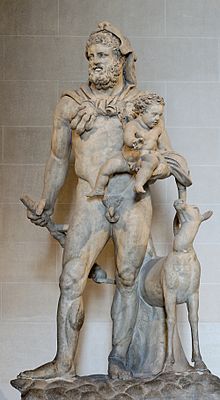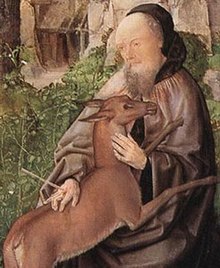Deer in mythology

Deer have significant roles in the mythology of various peoples.
In paleolithic cave paintings the figure of a shaman wears antlers as the deer-spirit, notably the figure being called "The Sorcerer" in the Cave Trois Frères in southern France. The Insular Celts worshiped the deer-goddess Flidais and held deer as supernatural animals, "fairy cattle" that were herded and milked by a localised and benevolent fairy giantess (a bean sìdhe) in each district, who could shift shape to that of a red deer;[1] in the West Highlands, she selected the individual deer that would be slain in the next day's hunt.[2] In Ireland, An Chailleach Bhéarach, "The Old Woman of Beare", an island off the coast of County Cork, takes the form of a deer to avoid capture; to Beare come characters from the Land of the Dead to visit Ireland.[3] Other Celtic mythological figures such as Oisin and Sadb were given connections to deer. The Continental Celtic Cernunnos is depicted with deer antlers in votive artwork and upon altars, and is possibly the horned figure on the Gundestrup cauldron. Cernunnos is most likely one of the multiple sources from which Wiccans synthesized the figure of their Horned God. The stag was worshipped alongside the bull at Alaca Höyük and continued in the Hittite mythology as the protective deity whose name is recorded as dKAL. Other Hittite gods were often depicted standing on the backs of stags.
In Jewish mythology - as discussed in the Talmud (חולין נט ע"ב) - exists a giant kind of stag by the name "Keresh". He is said to live in a mythical forest called "Divei Ilai".
The Scythians had some reverence for the stag, which is one of the most common motifs in their artwork, especially at funeral sites. The swift animal was believed to speed the spirits of the dead on their way, which perhaps explains the curious antlered headdresses found on horses buried at Pazyryk (illustrated, to the right).

In Greek mythology, the deer is particularly associated with Artemis in her role as virginal huntress. Actaeon witnessed Artemis bathing in a pool and was transformed into a stag that his own hounds tore to pieces. Callimachus, in his archly knowledgeable "Hymn III to Artemis", mentions the deer that drew the chariot of Artemis:
- in golden armor and belt, you yoked a golden chariot, bridled deer in gold.
One of the Labors of Heracles was to capture the Cerynian Hind sacred to Artemis and deliver it briefly to his patron, then rededicate it to Artemis. His son Telephos was exposed as an infant on the slopes of Tegea but nurtured by a doe.
In Norse mythology, the four stags of Yggdrasill feed on the world tree. The stag Eikþyrnir lives on top of Valhalla. The god Freyr killed Beli with an antler.
In Slavic mythology and folklore, Golden-horned deer is a large deer with golden antlers which often appear in fairytales. The legend of Saint Hubertus (or "Hubert") concerned an apparition of a stag with the crucifix between its horns, effecting the worldly and aristocratic Hubert's conversion to a saintly life.
In the story of Saint Hubertus, on Good Friday morning, when the faithful were crowding the churches, Hubertus sallied forth to the chase. As he was pursuing a magnificent stag the animal turned and, as the pious legend narrates, he was astounded at perceiving a crucifix standing between its antlers, which occasioned the change of heart that led him to a saintly life. The story of the hart appears first in one of the later legendary hagiographies (Bibliotheca hagiographica latina, nos. 3994-4002) and has been appropriated from the earelier legend of Saint Eustace or Placidus.

Saint Giles, a Catholic saint especially revered in the south of france, is reported to have lived for many years as a hermit in the forest near Nîmes, where in the greatest solitude he spent many years, his sole companion being a deer, or hind, who in some stories sustained him on her milk. In art, he is often depicted together with that hind.
In the founding legend of Le Puy-en-Velay, where a Christian church replaced a healinga megalithic dolmen. A local tradition had rededicated the curative virtue of the sacred site to Mary, who cured ailments by contact with the standing stone. When the founding bishop Vosy climbed the hill, he found that it was snow-covered in July; in the snowfall the tracks of a deer round the dolmen outlined the foundations of the future church.
Deer are considered messengers to the gods in Shinto, especially Kasuga Shrine in Nara Prefecture where a white deer had arrived from Kashima Shrine as its divine messenger. It has become a symbol of the city of Nara.
It is sometimes thought that stories about spectral deer may be the based upon tales of the now extinct Irish Elk (Megaloceros giganteus).
For the Huichol people of Mexico,[4] the "magical deer" represents both the power of maize to sustain the body and of the peyote cactus to feed and enlighten the spirit. Animals such as the eagle, jaguar, serpent and deer are of great importance to the Mexican indigenous cultures. For each group, however, one of these animals is of special significance and confers some of its qualities to the tribe. For the Huichol it is the deer that holds this intimate role. The character of the Huichol tends to be light, flexible and humorous. They have avoided open warfare, neither fighting against the Spanish nor Mexican governments, but holding to their own traditions. The Huichol hunt and sacrifice deer in their ceremonies. They make offerings to the Deer of the Maize to care for their crops, and to the Deer of the Peyote to bring them spiritual guidance and artistic inspiration
The spirit Furfur in The Goetia is depicted as a hart or winged hart.
In Hindu mythology, the goddess Saraswati takes the form of a red deer called Rohit according to the Aitareya Upanishad. Saraswati is the goddess of learning so learned men use deer skin as clothing and mats to sit upon. A golden deer plays an important role in the epic Ramayana. While in exile in the forest, Rama's wife Sita sees a golden deer and asks Rama and Lakshmana to get it for her. The deer is actually a rakshasa called Maricha in disguise. Maricha takes this form to lure Rama and Lakshmana away from sita so his brother Ravana can kidnap her.
Manufactured mythology
Quintus Sertorius, while a general in Lusitania, had a tame white stag which he had raised nearly from birth. Playing on the superstitions of the local tribes, he told them that it had been given to him by the goddess Diana; by attributing all his intelligence reports to the animal, he convinced the locals that it had the gift of prophecy. (See Plutarch's life of Sertorius and Pliny the Elder's chapter on stags (N.H., VIII.50)
The naming of the ship, the "Golden Hind", of Sir Francis Drake is sometimes given a mythological origin, though Drake actually renamed his flagship, in mid-voyage, 1577, as a gesture to flatter his patron Sir Christopher Hatton, whose armorial bearings included the crest "a hind Or." In heraldry, a "hind" is a doe.
The television series Hercules: The Legendary Journeys featured centaur-like "hinds" (creatures with upper bodies like women and lower bodies like hinds). Their blood was poisonous to the Greek gods, by nullifying their ichor.
Some new age religious practitioners have associated the appearance of docile deer at cremetion open houses with the state of a departed suicide's spirit. The deers' act of calmly watching human festivities indicates the spirit has moved toward the violet flame.
References
- ^ J. G. McKay, "The Deer-Cult and the Deer-Goddess Cult of the Ancient Caledonians"Folklore 43.2 (June 1932), pp. 144-174; McKay (p. 149) points out that the usual term for a giantess, ban-fhuamhair, a cannibal ogress, is never applied to the "Old Woman"
- ^ J.F. Campbell of Isalay, Popular Tales of the West Highlands, ii, no. 27, noted by McKay 1932:150.
- ^ "The Chase of Ben Gulbin" (McKay1932:151).
- ^ Barbara G. Myerhoff, "The Deer-Maize-Peyote Symbol Complex among the Huichol Indians of Mexico" Anthropological Quarterly 43.2 (April 1970), pp. 64-78.
